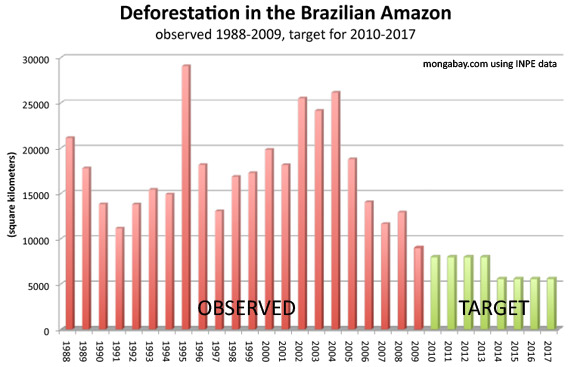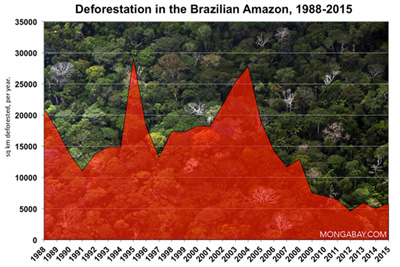Deforestation in the Brazilian Amazon may be on the rise again after reaching record-low levels last year, reports Brazil’s National Space Research Institute, INPE.
Data from INPE’s DETER system — a near-real time deforestation tracking mechanism — shows a near-doubling of forest clearing in March and April 2010 over the same period last year. Some 103.5 square kilometers of rainforest were lost according to INPE. Mato Grosso, a state where large-scale agriculture is rapidly expanding and the bulk of Brazil’s forest loss has occurred over the past decade, accounted for nearly three-quarters of the clear-cutting. Pará was second with 17 percent.
But the new figures likely underestimate deforestation. Month-to-month data during the rainy reason is notoriously spotty due to cloud cover. Annual deforestation in Brazil is assessed at the end of July why skies are generally clear.
The rise in deforestation is not unexpected. Forest clearing in the August 2008-July 2009 period was unusually low due to the global financial crisis, which dried up credit and depressed prices of commodities produced in the Amazon. Prices of beef and soy have surged since last year, while banks and commodity traders have resumed lending to farmers and ranchers. Brazil’s economy is booming, spurring new investment in the Amazon’s fast-growing agricultural sector.
Nevertheless, the rise in deforestation will need to be moderated if Brazil hopes to meet its ambitious emissions reduction target set forth in 2008. Under the plan, Brazil aims to limit Amazon deforestation to less than 8,000 square kilometers in 2010 versus an average annual rate of 19,500 sq km per year from 1996-2005. Last year 7,008 sq km of forest were cleared, the lowest loss since annual record-keeping began in the late 1980s. Brazil aims to meet its target through increased law enforcement, new protected areas, and financial incentives to promote sustainable forest use, conservation, and reforestation by landowners, including small farmers and agribusiness. The effort will be challenged by the difficulty of governing the vast and remote region as well as competing economic interests, which push for investment in infrastructure — especially roads and dams — that accelerates deforestation.

|








